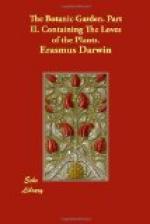“My Apocynum is not yet out of flower. I have often visited it, and have frequently found four or five flies, some alive, and some dead, in its flowers; they are generally caught by the trunk or proboscis, sometimes by the trunk and a leg; there is one at present only caught by a leg: I don’t know that this plant sleeps, as the flowers remain open in the night; yet the flies frequently make their escape. In a plant of Mr. Ordino’s, an ingenious gardener at Newark, who is possessed of a great collection of plants, I saw many flowers of an Apocynum with three dead flies in each; they are a thin-bodied fly, and rather less than the common house-fly; but I have seen two or three other sorts of flies thus arrested by the plant. Aug. 12, 1788.”
P. 18. Additional note on Ilex. The efficient cause which renders the hollies prickly in Needwood Forest only as high as the animals can reach them, may arise from the lower branches being constantly cropped by them, and thus shoot forth more luxuriant foliage: it is probable the shears in garden-hollies may produce the same effect, which is equally curious, as prickles are not thus produced on other plants.
P. 41. Additional note on Ulva. M. Hubert made some observations on the air contained in the cavities of the bambou. The stems of these canes were from 40 to 50 feet in height, and 4 or 5 inches in diameter, and might contain about 30 pints of elastic air. He cut a bambou, and introduced a lighted candle into the cavity, which was extinguished immediately on its entrance. He tried this about 60 times in a cavity of the bambou, containing about two pints. He introduced mice at different times into these cavities, which seemed to be somewhat affected, but soon recovered their agility. The stem of the bambou is not hollow till it rises more than one foot from the earth; the divisions between the cavities are convex downwards. Observ. sur la Physique par M. Rozier, l. 33. p. 130.
P. 65. Additional note on Gossypium.
--------emerging Naiads cull From leathery pods the vegetable wool. ——eam circum Milesia vellera nymphae Carpebant, hyali saturo fucata colore. Virg. Georg. IV. 334.
P. 119. Addition to Orchis. The two following lines were by mistake omitted; they were to have been inserted after l. 282, p. 119.
Saw on his helm, her virgin
hands inwove,
Bright stars of gold, and mystic knots of
love;
P. 136. Addition to the note on Tropaeolum. In Sweden a very curious phenomenon has been observed on certain flowers, by M. Haggren, Lecturer in Natural History. One evening be perceived a faint flash of light repeatedly dart from a Marigold; surprized at such an uncommon appearance, he resolved to examine it with attention; and, to be assured that it was no deception of the eye, he placed a man near him, with orders to make a signal at the moment when he observed the light. They both saw it constantly at the same moment.




